An Example Of How The St louis Region Fails Pedestrians, Transit Users
Part of the implied contract when taking a bus to a destination is when you’re dropped off at your stop, you’ll be able to get to the corresponding stop in the opposite direction for the return trip. Seems simple enough, right? But in many parts of the St. Louis region being able to reach a bus stop in the opposite direction is impossible if you’re disabled. I don’t go looking for them, I run across them just going about my life.
Since the Americans with Disabilities Act of 1990 became law, transit operators, like Metro St. Louis, formerly Bi-State Development Agency, have equipped their fleet of buses with either a lift or ramp in new low-floor models. This permits those us who use wheelchairs to board every bus with access to hundreds of routes throughout the region — theoretically, at least. Bus routes are operated on municipal/county roads throughout our region. The responsibility for these public rights-of-way (PROW) are that of the municipality, county, or state — depending upon the entity that has assumed responsibility. Regardless, the transit agency generally isn’t responsible for the pedestrian infrastructure (sidewalks, curb cuts. etc) to/from their bus stops.
Today’s example involves a 2.5 mile stretch of Manchester Ave from McCausland Ave to Kingshighway Blvd — all in the City of St. Louis. A third of this stretch is fronted by the St. Louis Marketplace — a strip retail center that opened in 1992 — it was St. Louis’ very first TIF project. A former industrial area was reclaimed for retail by relocating railroad tracks further away from Manchester. The entire site was new from scratch and post-ADA. Furthermore, Manchester Ave has had a bus route for the entire 26 years I’ve lived in St. Louis — probably for at least 3-4 decades. For years it was the #59, but after the Cross County MetroLink line opened in 2006 the #59 stops at Maplewood and the #32 was extended West to Maplewood.
The morning of August 11th my husband forgot his phone, so I decided to take it to him. His morning client lives a few blocks North of Manchester Ave. in the Franz Park neighborhood (aka Dogtown), 24th ward. With my car key I was able to leave his phone in the door pocket and a note on the seat. I needed to return to Manchester Ave and catch the #32 Eastbound.
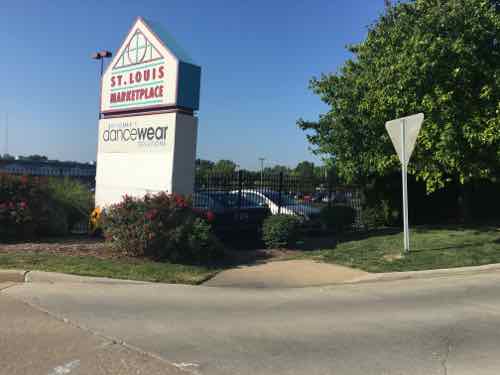
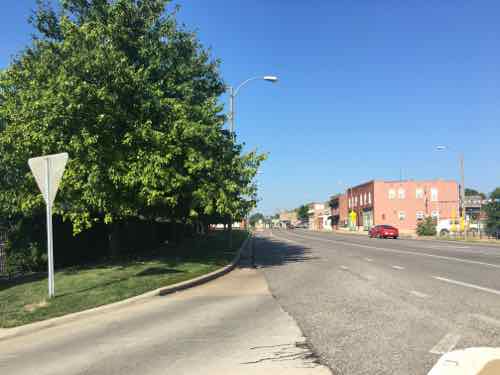
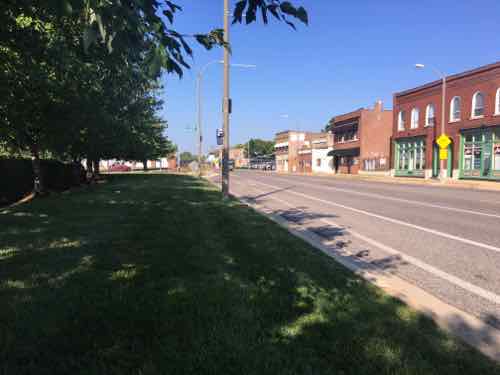
When I boarded the bus from this stop the driver asked me how I managed to get to the stop! On the bus I noticed a stop further East that I’ve blogged about before.

I paid attention to all the stops as we passed each one. I decided I needed to look at the entire stretch, not just one stop here or there. Again, the distance between Kingshighway and McCausland is 2.5 miles. There are 12 MetroBus stops in each direction. All 12 in the Westbound direction are accessible — not ideal but adequate. However, in the Eastbound direction only half are accessible/adequate.
Six aren’t accessible, although I was able to power through the grass to reach one of them. Four of these six inaccessible bus stops are in front of the St. Louis Marketplace, the retail development that was created 100% from scratch after the ADA became law. Let’s take a look.
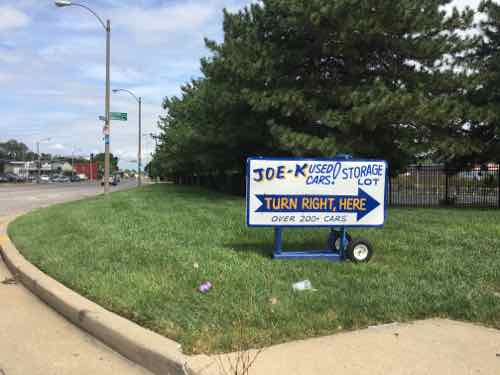
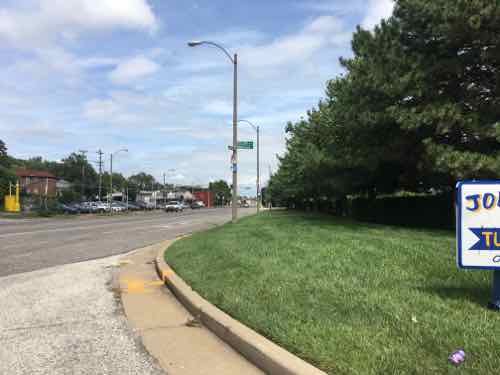
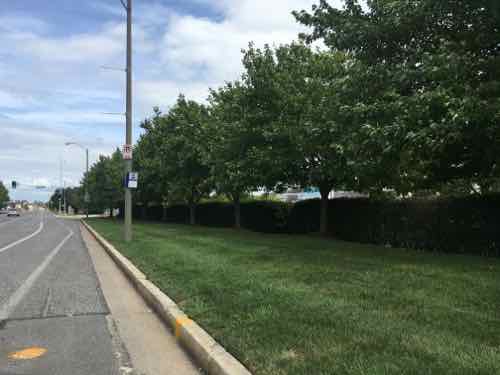
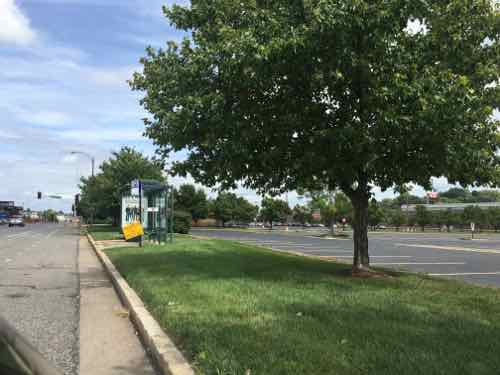
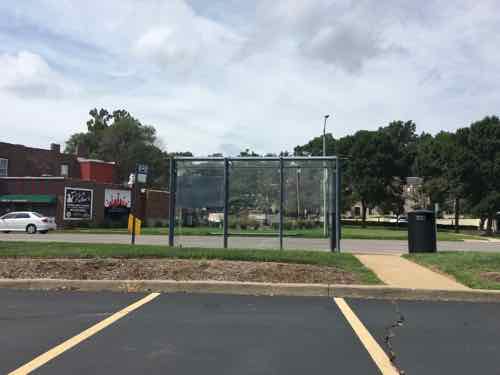
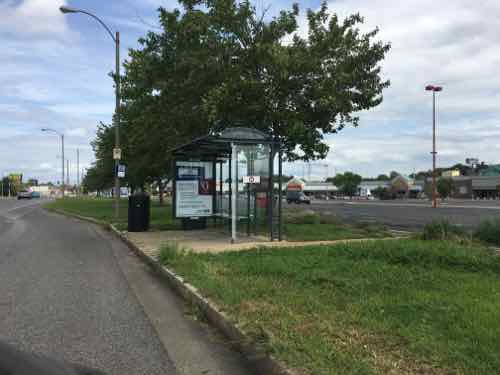
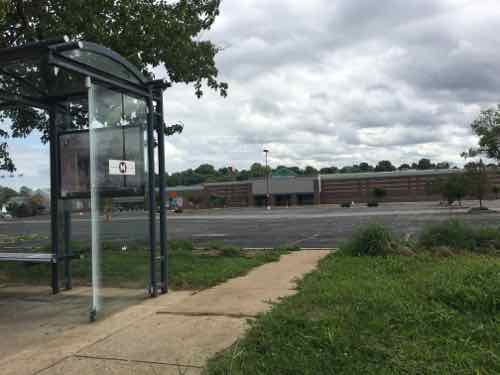
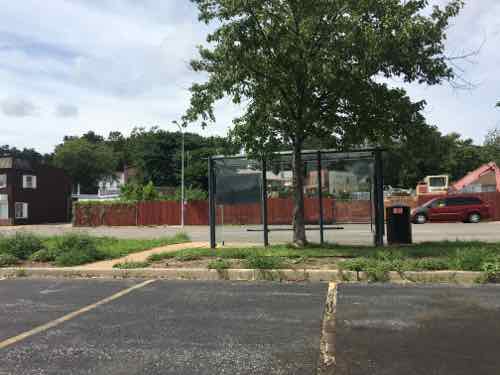
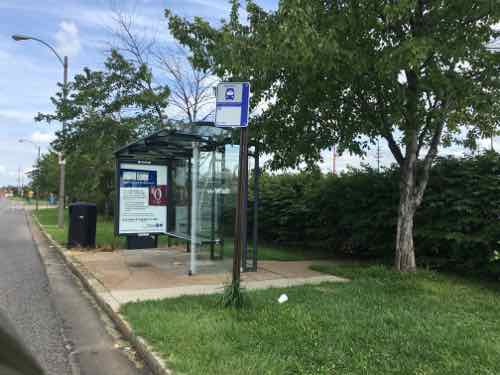
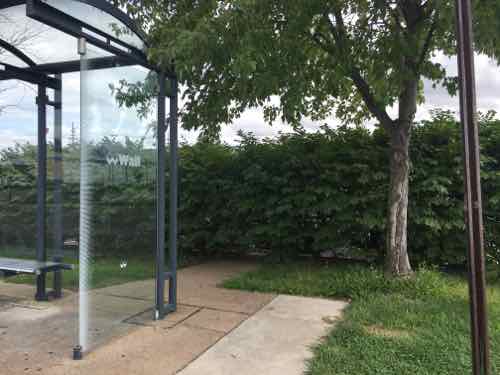

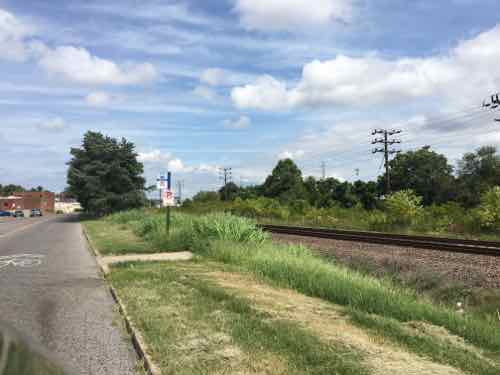
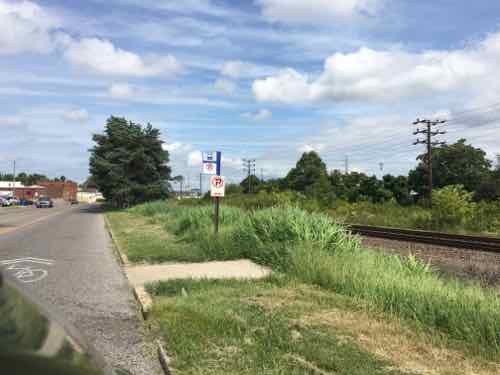
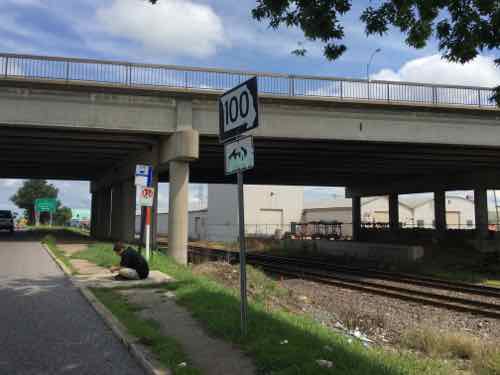
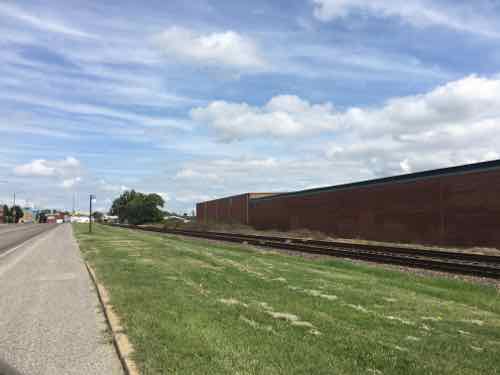
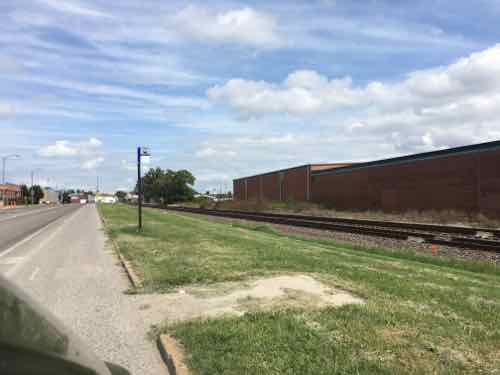
Previous posts on a couple of bus stops on this stretch of Manchester:
- September 2015: Dangerous Reaching Bus Stop On Manchester At Hampton
- November 2015: Macklind Ave Is An Inaccesible, Incomplete Street
Gee, I wonder why few walk or use public transit? Seems so inviting…
— Steve Patterson
Few use transit, but definitely not for the reasons you suggest.
So, were you trying to get to Charter or to K-Mart?
Yes, this stretch of Manchester is NOT pedestrian friendly. The question is if it should be the biggest priority for the city to invest money in trying to improve pedestrian access, here? If “there’s no there, there”, wouldn’t it make more sense to spend money making multiple small improvements, fixing the missing links, in more-walkable areas, places where people actually walk? Places like the CWE, Cortex, Tower Grove or South Hampton?
I agree, everyone should fully embrace the ADA and do everything in their power to make it reality. Unfortunately, not everyone is as enthusiastic, and dollars are limited / finite.
As I wrote, I was just trying to return to downtown. I can get off the bus at 12 stops heading Westbound but only 6 to return Eastbound. The city & developer started from scratch in the sarky 90s, St. Louis Marketplace opened two years after the ADA was signed.
It failed as a retail development, partly because it isn’r welcoming to pedestrians/transit users.
It failed primarily because of location and tenant mix. The fact that it’s not welcoming to pedestrians or transit users is truly secondary. And if that WERE really the case, the Galleria, West County Mall, Brentwood Promenade, etc, etc, would all have also failed, as well, since their ped/transit access is equally as bad (if not worse) AND downtown would still be the retail heart of the region!
The tenant mix was excel;lent in 1992, the poor (read suburban) design failed to attract customers and retain tenants.
The idea that the Galleria is anywhere near as bad as St. Louis Marketplace is laughable at best. The St. Louis Galleria has a) bus stops literally right in front of the mall and b) curb-cut sidewalks on Clayton and Brentwood. The entrance from the rehab center/Immacolata side is a joke, true, but it’s not as if it’s anywhere near as impossible as St. Louis Marketplace,
Now, of course, actually getting the mall’s doors OPEN is a different story…
The way I see it, these design “oversights” severely diminish the value of bus service in the City and region. which in turn diminishes ridership on the system — a system the region’s population supports heavily through its self-imposed taxes.
I agree, somewhat, that the money should be focused on the areas that place a higher value and respect on walkability and transit access. But as the Stenger-Slay Metrolink kerfuffle highlighted, that’s a hard row to hoe. At the very least, I feel Bi-State would be within its rights to temporarily cease operations in areas where instances like those Steve noted occur — force leadership’s hand (in this case, State/MoDOT and, presumably, the City of St. Louis) to accommodate this program which received overwhelming support.
If you cease operations, even “temporarily”, the only people who will really suffer are the people who ride the bus!
As noted earlier, Metro has to work with what they’re given. If the pedestrian infrastructure sucks, it’s not really their fault / problem. Yes, there are riders with special needs, but there’s a whole lot more riders who just need to get to their jobs (and other places, as well), and are willing to put up with crappy infrastructure, just because it beats the alternative of WALKING (or not being able to have that job, at all)!
The ONLY way to get many property owners to “do the right thing” is to either sue ’em or don’t give ’em their permits / CO’s / occupancy permits / licenses that they need to operate. Laws without real consequences will (and do) get ignored. But when you’re hitting them on their bottom line, they start to pay attention.
If the working poor can’t get to work the economy would stop. White collar workers wouldn’t get their lattes, lunch, receive new hotel linens, trash would pile up quickly. The economy needs these workers to be able to reach their jobs.
The property owner in my example is the City of St. Louis or MoDOT — the adjacent property owner on either side isn’t responsible for the public right-of-way (PROW). We’d need to unearth the original development agreement from 1990/91 to see who was supposed to build a sidewalk. The development has the one required access route — but there’s no public sidewalk for it to connect to.
In many municipalities, if you want to develop a property, you also have to develop common area improvements to support the development. Streets, sewers, traffic signals, ADA curb cuts,sidewalks are folded into the mix at the expense of the developer.
I believe there’s a legal cause of action for individuals against cities and states for ADA violations, IIRC, and I *think* sovereign immunity was explicitly rejected. This is an ADA violation by either the city or the state — not clear which.
It took a decade of legal work to establish clearly that sidewalks must be made ADA compliant whenever a road is repaired. It’s worth building on that with cases to prove that cities are violating the ADA when they repair or alter a road without a sidewalk (and without a woonerf).
….and without white collar workers, there might be less demand for “lattes,” espressos, cappuccinos, ristrettos, clean hotel linens and served lunches that aren’t carried to work daily in a lunch pail. It takes a village. And so, without the white collar workers, there would be less need for “working poor” –they’d be just “poor.” But everyone’s trash would pile up equally, provided anyone had any trash to discard..
That’s getting to the heart of it, yes. For new construction, these considerations should be made as standard, and demanded as a reality of building/doing business in what should be an accessible City, really. For instances like what’s happening on McCausland, the City and/or State is responsible for creating and maintaining these standards. If the City and/or State opts to ignore those standards, or deem them unnecessary in this location, then Bi-State should probably just pull service, both as a matter of caution/risk and as a consideration of the system’s balance.
Actually, Bi-State can and should sue the City and/or State, but they won’t because of their position. It is therefore up to citizens to sue the City and/or State.
You’ve hit the nail on the head, suggesting that certificates of occupancy be withheld until both the building and the site meet current code requirements and common sense standards. In several areas of California, from the outset of development, developers are required during plan review to sign off on a statement of conditional agreement, which stipulates that a building will not be occupied unless/until all approval agencies are satisfied that the development is “worthy of occupancy,” even AFTER construction is complete and regardless of whether the work is included in the original documents. So if an issue/problem gets past plan review without detection, which can and does happen often, the developer is still responsible, which can definitely jerk a knot in his tail. This is an extreme situation, which occurs only in popular and coveted development areas. But in lesser areas, if municipalities would insist on a pre-construction site development conference with developer, contractors and architect/civil engineer, so many of these site-development oversights could be avoided. Communication is the key toward addressing and solving so many of these site access oversights. And I firmly believe that many are just that–oversights. And simply by walking the site after the building has been erected and after site layout is completed but before any concrete sitework is poured, we design people can begin to do a better job for our clients and building users.
I agree completely!
One state that does do it well is Texas. If we could follow their lead and impose state-wide standards, with some teeth, we could get away from the continued blog posts about why things don’t work, here, followed by a few random, symbolic gestures toward compliance . . . https://www.tdlr.texas.gov/ab/abtas.htm
Even if Missouri were to pass a statewide law the existing built environment would remain problematic. The ADA was signed 26 years ago yet this hasn’t been addressed.
There is absolutely no way to justify ADA non-compliance. But I find it interesting that for the last 26+++++ years in STL, (since the ADA act) any municipal candidate wearing an elephant or non-donkey (I’m being nice) logo on his shirt isn’t given serious consideration for political office. STL voters merely pass the same torch to a different candidate who vows to support the same old-city politics, as usual. It’s a foregone conclusion that the Democrat who wins the primary, automatically wins the election. How limiting! In STL, the good-ol’-boy network is destroying the city. So often, someone at the top at City Hall regularly plays golf with, receives major campaign assistance from, or is regularly hosted at Tony’s then at Busch Stadium by local major league contractors and design firms, and/or by well-connected attorneys and PR firms who represent them. And so often a blind eye is turned toward so many of these non-lifesafety ADA and other jobsite *design and construction failures and oversights –in STL and in other similar cities. “We’ll do better next time!” But in other cities, politics don’t interfere with ADA compliance. From my experience, it doesn’t exist in LA, San Francisco, Dallas, Plano, Austin, Kyoto, Tel Aviv, Seoul, most major cities in Germany and in other progressive cities in Europe, and in so many other major cities. It’s interesting that these cities where politics stay out of development are coincidentally very vibrant and growing. I wouldn’t say that those two adjectives describe STL.
But selective enforcement is just one of several disadvantages of a city whose voters recognize only those candidates who are represented by single political party. It’s as limiting as an educational system that recognizes only one set of assumptions about learning and academics and curriculum. After high school, who would want his child to accept the status quo?
So often, ADA and other project-related issues and problems aren’t as obvious on paper as they are in real life. I’ve studied structural drawings, approved them, then walked in the field months later, looked at the structural framing and said, “oh, shit” –and this has happened more than a few times in my career.
Construction permit fees should be increased to include more and much more informed in-the-flesh jobsite inspectors. Drive-by inspections or inspections performed by the clueless should be past-tense. I’ve heard stories about a certain retired plumbing inspector in STL who did his inspections over lunch with the contractor at a certain restaurant on the Hill. Thank god he’s gone. In LA and in other vibrant and growing cities, full time “state architects” are assigned to projects that involve extensive structural work. This is critical since the engineer cannot remain on the job full time. Maybe if STL would hire a few (more?) ADA enforcement officers, give them adequate authority, and absolutely leave politics out of the equation, things would improve in STL. Until attitudes and perspectives change, 26 years from now will be no different in STL.
The big problem here is that the city and state ROAD departments refuse to build sidewalks as a matter of course (and continue to set high speed limits which make sidewalks absolutely necessary — woonerfs would be fine but that’s not what we’re looking at here). If the road departments were installing sidewalks whenever they did a resurfacing — which they are *supposed to be doing* — the problems would be fixed within 20 years.
As far as I can tell, it’s a straight-up ADA violation to build a road with a high speed limit (other than a limited-access expressway) without a sidewalk. Pedestrians have the legal right to walk on such roads (a legal right dating back over 1000 years) but disabled people are at much greater risk than able-bodied people of getting hit by fast automobiles when doing so (although *everyone* is at risk, it’s worse for those in wheelchairs who can’t step into the gutter as easily) — so it’s discrimination.
But this hasn’t been firmly established in court yet. It needs to be established. I’ll be happy to help if we can get some sort of organized, coordinated movement with some disability rights organizations (United Spinal, perhaps?).
–Nathanael Nerode
Other states have groups that are willing to sue – Colorado has both http://www.ccdconline.org/ and http://coddc.org/ – along with lawyers willing to pursue the cases – https://disabilitylawco.org/ – Texas has strong state laws – https://www.tdlr.texas.gov/ab/abtas.htm – and you’re seeing a lot more happen. The problem, here, both locally and at the state level, besides a lack of political will, is simply a lack of dollars. And along this stretch of Manchester, is there really a reason to put a sidewalk between the street and the railroad tracks IF there’s a continuous sidewalk on the opposite, occupied, north side? If “there’s no there, there”, for pedestrians, why invest in a strip of concrete that a) won’t be used, and b) won’t be maintained, when there are hundreds of intersections, elsewhere, lacking needed curb ramps and dozens of bridges around the city lacking any sort of adequate pedestrian facilities? I get it, we should do the right thing everywhere, but that simply ain’t going to happen, very quickly. By necessity, we need to prioritize how our scarce, finite tax dollars are spent, and wasting them on symbolic gestures, like a shiny new sidewalk next to a railroad track, instead of solving actual problems, isn’t very smart . . .
Woonerfs are great as long as speed limits (for bikes and motorized vehicles) are enforced and pollution-limiting measures are in place (as in Berlin’s Alexanderplatz), where police are not stingy with issuing speeding citations to cyclists and motorists, and where green-tags are issued to restrict usage to eco-friendly motorized vehicles. Much like roundabouts. Last week I drove from Plano to Baton Rouge to look at one of our projects that had sustained flood damage, and at the 1-12 exit I found myself on a newly constructed section of a 2+mile stretch of roundabouts, where the design was actually a success due to intelligently-placed yield signs and conspicuous speed-limit enforcement. Enforcement officers on scooters were present along the route, enforcing speed limits which averaged 15 MPH. The traffic flow was smooth and sweet (although a bit slow) in an area outside Baton Rouge where the route would otherwise have been a quagmire due to the inordinate number of intersecting roadways, including 1-12. Enforcement to assure success of woonerfs is the key, because otherwise they are no safer than widened roadways with contiguous bike lanes.
You’re right, it would do little to address existing conditions, but it would do a lot to bring compliance on new projects, including tenant finish projects, into this century. And as you well know, the ADA is civil rights legislation, and compliance is done retrospectively, in court, not proactively, during the permitting process. If no one complains, legally, nothing much happens. Unless and until you, or someone else, does more than blog about the problems, and actually files a complaint with the DOJ or takes it upon themselves to sue the problem property owner in state or federal court, what legal reason does any property owner have to “do the right thing”?!
There really needs to be some sort of class action lawsuit about this sort of crap. The city has two choices:
(1) build sidewalks along the entire length of the street
(2) reduce the speed limit on the street to 20 mph or less and explicitly state that pedestrians are supposed to walk (or roll their wheelchairs) in the street.
The cities won’t like it, but the ADA is quite clear about this.
And then there are the freeways . . . https://mdphoto.myportfolio.com/60-years-the-interstate-highway-system-st-louis
At least we don’t have anything this bad: https://s-media-cache-ak0.pinimg.com/564x/13/a2/8c/13a28cfce5c9fe3fcc4913874b68f035.jpg